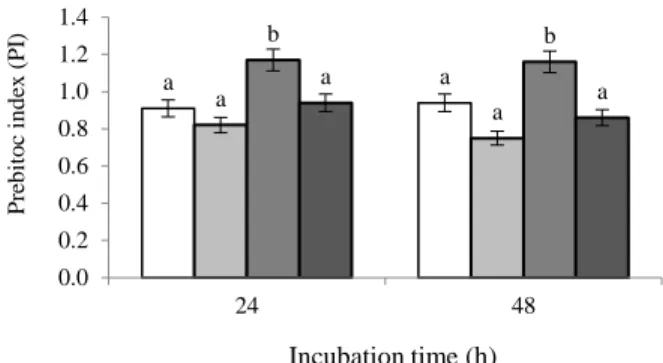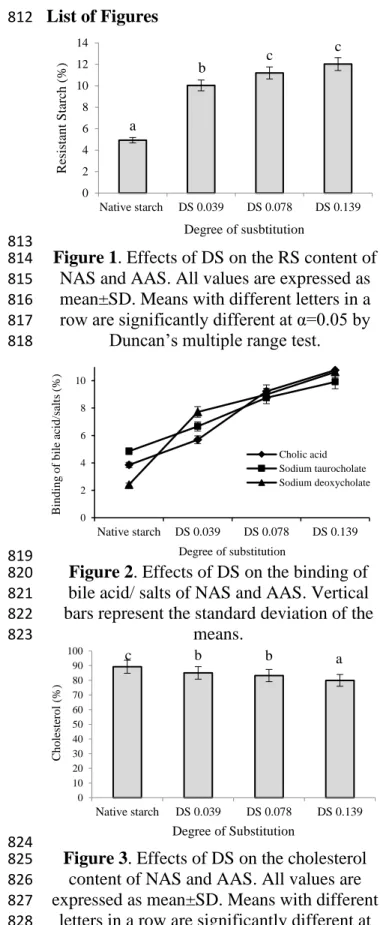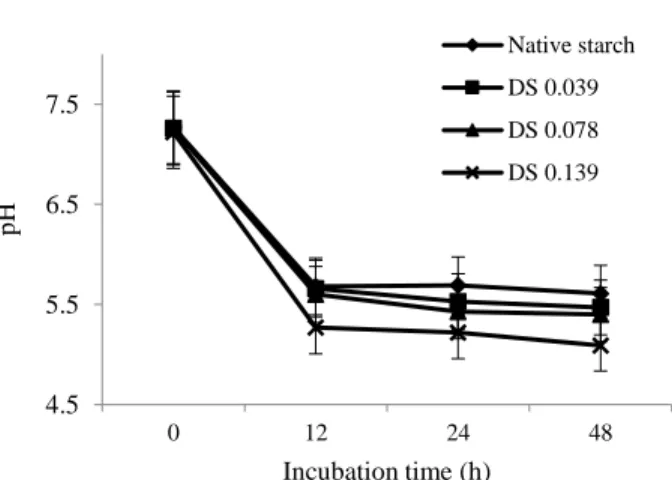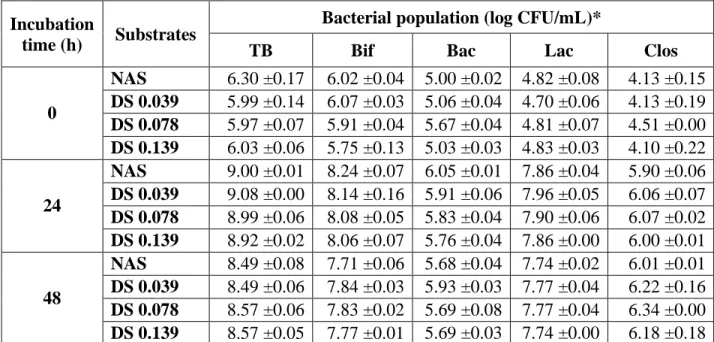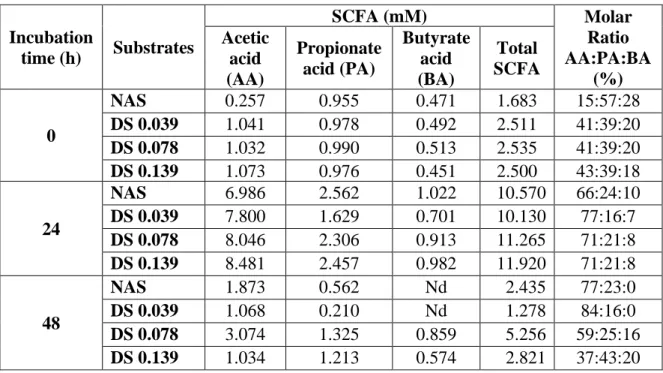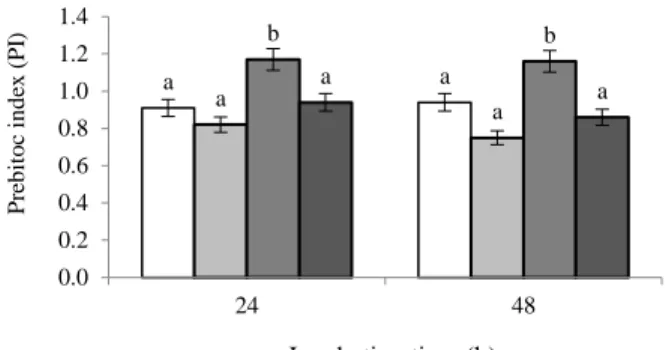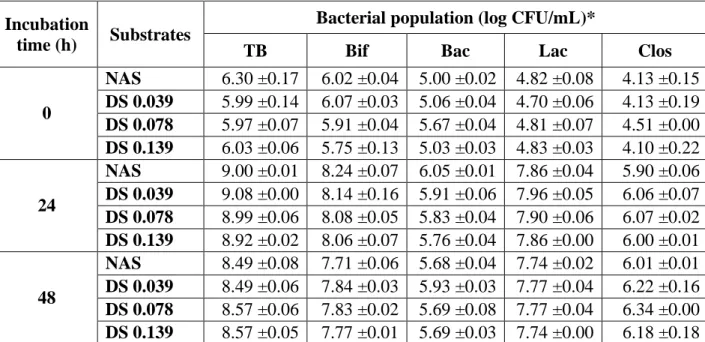Determination of the degree of substitution of acetylated starch by hydrolysis, 1H NMR and TGA/IR. Evaluation of the prebiotic of wheat arabinoxylan fractions and induction of hydrolase activity in intestinal microflora.
CARPATHIAN JOURNAL OF FOOD SCIENCE AND TECHNOLOGY
FUNCTIONAL AND PREBIOTIC PROPERTIES OF ACETYLATED ARENGA
STARCHES WITH DIFFERENT DEGREE OF SUBSTITUTION
Introduction 11
RS from acetylated starches fermentation 71. produces in the large intestine is generally 72. recognized as beneficial for host maintenance 73. It has been reported that 81. as a whole, SCFA acidifies the luminal pH, 82. which suppresses the growth of pathogens , 83. acetate is particularly seen as a lipogenic 87. compound while propionate acts as a 88. glucogenic substrate and an inhibitor of 89.
Materials and methods 102
- Materials 103
- Preparation of acetylated arenga starch 112
- Determination of resistant starch 137
- The bile acids/salts binding 158
- The cholesterol binding 176
- Preparation and operation of batch 189
- Bacterial enumeration 221
- Calculation of prebiotic index 249
- Determination of pH 265
- Determination of organic acid 270
SCFA) are fermentation end products of the 75. intestinal microbiota that use to exert a 76. extensive influence on host physiology 77. through nutritional, regulatory and immune 78. as signals for the regulation of virulence genes 80. Bacteroides spp . ; fortified clostridial agar, 236. supplemented per liter with 8 mg novobiocin 237. and 8 mg colistin, for Clostridium spp.; rogosa 238. acetic acid L-1, for Lactobacillus spp.;.
Results and discussions 300
- Resistant starch 301
- Binding of bile acid/salts 322
- Reduction of total cholesterol 349
- Modulation of bacterial population 374
- Prebiotic index 409
- The pH changes along fermentation 446
- Production of short chain fatty acids 464
Conclusions 505
The objective of this research was to evaluate the functional properties and in vitro fermentation of the potential prebiotic native arenga starch (NAS) and AAS with DS 0.039, DS 0.078 and DS 0.139. The pH drops rapidly during the first 12 h and was then found constant in all NAS and AAS media.
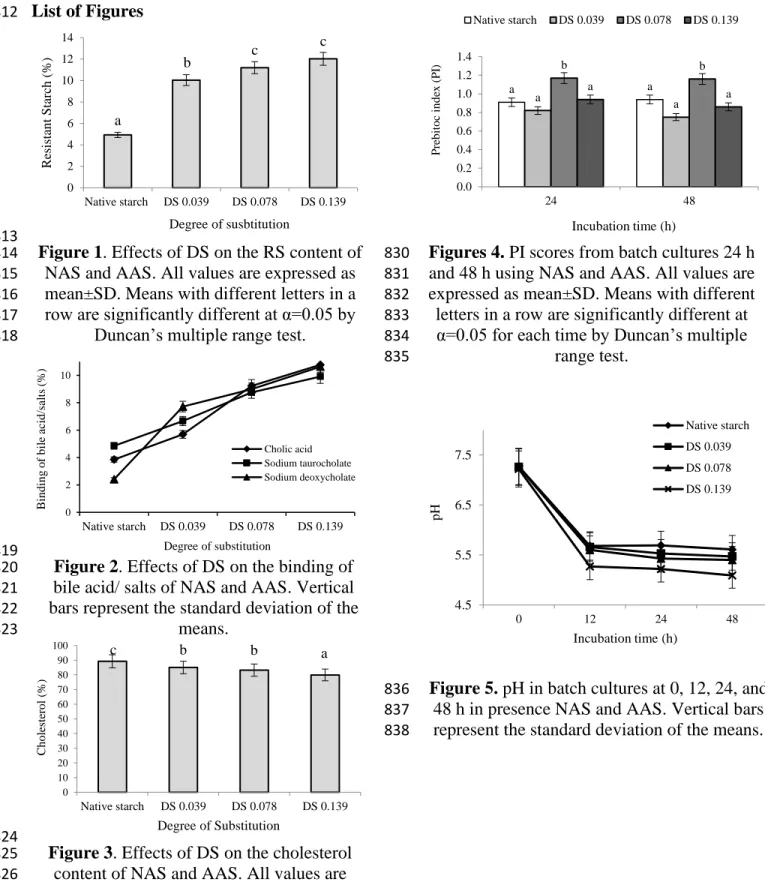
Introduction 11
Butyrate is a major energy substrate 90 and also a regulator of colon cancer cells by promoting apoptosis 94 .
Introduction 8
Arenga starch obtained from the pith of palm sugar (Arenga pinnata) and subjected to chemical modification by acetylation, acetylated arega starches (AAS) with different degree of substitution (DS) were produced. The products had functional properties including resistant starch (RS) content, bile acid binding, cholesterol reduction and potential prebiotic including bacterial growth, prebiotic index (PI), pH changes and short chain fatty acids (SCFA) . Functional properties such as RS and bile acid binding increased as DS increased, and total cholesterol decreased as DS increased.
All AAS produced a significant increase in SCFA production, indicating that they were fermented by the gut microbiota. In conclusion, AAS can be used as an alternative or complementary treatment in hypercholesterolemia and are fermented by intestinal bacteria and showed potential to be used as a new source of prebiotics. RS of acetylated starch fermentation 68. produces in the colon is generally 69. recognized as beneficial in maintaining host 70.
Materials and methods 99
- Materials 100
- Preparation of acetylated arenga starch 109
- Determination of resistant starch 134
- The bile acids/salts binding 155
- The cholesterol binding 173
- Preparation and operation of batch 186
- Bacterial enumeration 218
- Calculation of prebiotic index 246
- Determination of pH 262
- Determination of organic acid 267
- Statistical analysis 288
It is considered a 54. functional component of food because of the 55. health benefits it confers as a result 56. RS intake lowers postprandial glycemic 58. lowers plasma cholesterol and triglyceride 60. increases satiety and reduces fat storage 62. promotes the growth of beneficial 64. microorganisms such as bifidobacteria and 65. lactobacilli, which exert very beneficial 66. SCFA) are fermentation end products of the 72. intestinal microbiota that use exert a 73. extensive influence on host physiology 74 through. nutritional, regulatory and immune 75. as signals for the regulation of virulence genes 77. It has been reported that 78. as a whole, SCFA acidifies the luminal pH, 79. which suppresses the growth of pathogens, 80. acetate was especially seen as a lipogenic 84. compound while propionate acts as a 85. glucogenic substrate and an inhibitor of 86.
Samples from each container were 219. immediately transferred to anaerobic 220. diluted with pre-reduced half strength peptone 223. dilutions were plated in duplicate on agar 226. Selective growth media used 228. were the total number of plates, for total bacteria; . trypticase soy agar supplemented with 230. vancomycin per liter and 50 ml of purified horse blood, for 232. Bacteroides spp.; fortified clostridial agar, 233. supplemented per liter with 8 mg of novobiocin 234. and 8 mg of colistin, for Clostridium spp.; rogosa 235. acetic acid L-1, for Lactobacillus spp.;.
Results and discussions 297
- Resistant starch 298
- Binding of bile acid/salts 319
- Reduction of total cholesterol 346
- Modulation of bacterial population 371
- Prebiotic index 406
- The pH changes along fermentation 443
- Production of short chain fatty acids 461
Conclusions 502
AM Yahoo Mail - RE: Manuscript for publication in the Carpathian Journal of Food Scince and Technology (CJFST). 9/7/2021 Yahoo Mail - RE: Manuscript for publication in the Carpathian Journal of Food Science and Technology (CJFST). Subject: Re: Manuscript for publication in the Carpathian Journal of Food Scince and Technology (CJFST).
Subject: RE: Manuscript for publication in the Carpathian Journal of Food Science and Technology (CJFST). 09/07/2021 Yahoo Mail - RE: Manuscript for publication in the Carpathian Journal of Food Scince and Technology (CJFST). Editor: Carpathian Journal of Food Science and Technology Thank you for your information.
FUNCTIONAL AND PREBIOTIC PROPERTIES OF ACETYLATED ARENGA STARCHES WITH DIFFERENT DEGREES OF SUBSTITUTION". CJFST34.2017.03 has passed the review process and has been accepted for publication in the Carpathian Journal of Food Science and Technology as is without correction. FUNCTIONAL AND PREBIOTIC PROPERTIES OF ACETYLATED ARENGA STARCHES WITH DIFFERENT DEGREES OF SUBSTITUTION " .. CJFST34.2017.03 has passed the review process and has been accepted for publication in the Carpathian Journal of Food Science and Technology as is without correction.
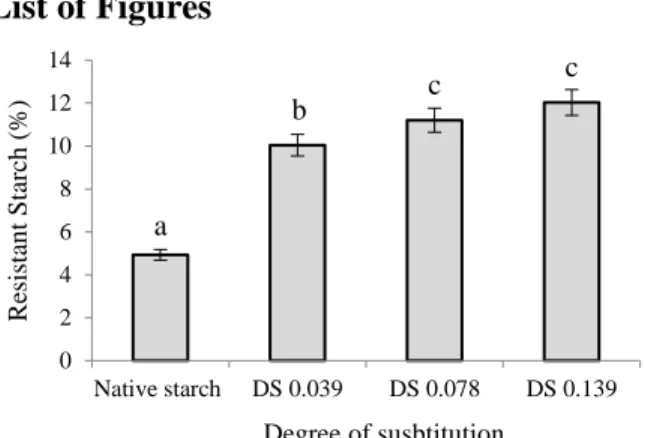
FUNCTIONAL AND PREBIOTIC PROPERTIES OF ACETYLATED ARENGA STARCHES WITH DIFFERENT DEGREE OF SUBSTITUTION
Introduction
Acylated starch with a low degree of substitution (DS) is usually obtained by esterification of native starch in an aqueous medium in the presence of an alkaline catalyst. Starch acetates are commercially prepared with low (< 0.1) DS by reacting an aqueous suspension of starch granules with acetic anhydride (Biswas et al., 2008). Many studies show that RS intake reduces the postprandial glycemic and insulinemic response (Li et al., 2010), lowers plasma concentrations of cholesterol and triglycerides (Liu & Ogawa, 2009), increases satiety and reduces fat storage (Chiu & Stewart, 2013).
RS from acetylated starches that produce fermentation in the colon is widely recognized as beneficial for maintaining host homeostasis. Providing butyrate as an important energy substrate as well as a regulator of cell growth and differentiation (Hong et al., 2005; . Ge et al., 2005), butyrate can reduce the risk of colon cancer by stimulating apoptosis of colonocytes ( Furusawa) et al., 2013; Gao et al., 2009). In the present study, acetylated starches were prepared by reacting arenga starch (Arenga pinnata Merr.) with acetic anhydride in aqueous suspension to evaluate the effect of DS on the functional properties and prebiotic potential of acetylated arenga starches.
Materials and methods 1. Materials
- Preparation of acetylated arenga starch The acetylated arenga starches (AAS) was
- Determination of resistant starch
- The bile acids/salts binding
- The cholesterol binding
- Preparation and operation of batch fermenters
- Bacterial enumeration
- Calculation of prebiotic index
- Determination of pH
- Determination of organic acid
- Statistical analysis
RS is explained as the fraction of starch that escapes digestion in the small intestine and passes into the large intestine, where it is more or less fermented by intestinal microflora. RS determined as a dietary fiber according to the enzymatic gravimetric method (Ebihara et al., 2006). The binding of bile acids/salts (cholic acid, sodium taurocholic acid, sodium deoxycholic acid) was measured by in vitro assay (Smietana et al., 2000).
Fresh faecal samples from a healthy human volunteer with no history of antibiotic treatment in the previous 3 months were first diluted (1:10) in anaerobic buffer containing 0.1 M phosphate-buffered saline ( PBS), pH 7.0, and then homogenized. using a magnetic stirrer at normal speed for 2 min. The equation embodies the assumption that an increase in bifidobacteria and/or lactobacilli populations is a positive effect, while an increase in bacteroids and/or clostridia is a negative effect. The pH of the samples was determined using a digital pH meter (Eutech Instruments, Cyberscan) calibrated with buffers at pH 4.0 and 7.0 (Fisher Scientific, UK).
Results and discussions 1. Resistant starch
- Binding of bile acid/salts
- Reduction of total cholesterol
- Modulation of bacterial population The effect of the addition of NAS and AAS
- Prebiotic index
- The pH changes along fermentation The decrease of the pH along fermentations
- Production of short chain fatty acids The concentration of total, acetate,
Previous studies have indicated enhancement of bifidobacteria and lactobacilli, the main targets of prebiotic action in the presence of RS (Salazar et al., 2009; Ramnani et al., 2010). The prebiotic property of the produced NAS and AAS was evaluated by in vitro faecal batch culture. PI represents a comparative ratio between the growth of beneficial bacteria, such as bifidobacteria and lactobacilli, and the growth of the undesirable ones, such as bacteriodes and clostridia.
In this study, most bifidobacteria and lactobacilli grew better on AAS compared to other selected intestinal bacteria. On the other hand, all types of Bacteroides and Clostridia showed very low growth on AAS substrates. Structural changes of AAS during degradation may affect fermentation patterns, including SCFA composition.
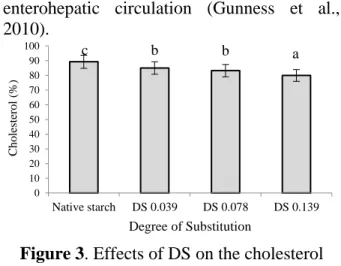
Conclusions
Preparation of acetylated waxy, normal and high-amylose maize starches with intermediate degrees of substitution in aqueous solution and their properties. Please find the final proof of your manuscript FUNCTIONAL AND PREBIOTIC PROPERTIES OF ACETYLATED ARENGA STARCHES WITH DI. FUNCTIONAL AND PREBIOTIC PROPERTIES OF GASETYLATED ARENGA STARCHES WITH DIFFERENT DEGREES OF SUBSTITUTION STARCHES WITH DIFFERENT DEGREES OF SUBSTITUTION.
Chemical modification of starch by acetylation has been extensively investigated (Bello et al., 2010; Luo &. Acetylation can be performed to improve the physical, chemical and functional properties of starch (Xu et al., 2004). In the current study, acetylated starches were prepared by the reaction of areng starch with acetic anhydride in aqueous slurry to evaluate the effect of DS on the functional properties and prebiotic potential of acetylated areng starches.
Materialsandmethods 1.Materials
- Preparation of acetylated arenga starch The acetylated arenga starches (AAS)
- Modulation of bacterial population The effect of the addition of NAS and
- The pH changes along fermentation The decrease of the pH along
After the addition of acetic anhydride was complete, the reaction was continued for 60 minutes and stopped, adjusting the pH to 4.5 with 0.5 N HCl. The pH of the solution was adjusted to 4.5 by the addition of 1 N HCl and the sample was incubated with amyloglucosidase at 60 °C for 45 minutes. The pH of the samples was determined using a digital pH meter (Eutech instruments, Cyber scan) calibrated with buffers at pH 4.0 and 7.0 (Fisher Scientific, UK).
Modulation of bacterial population The effect of the addition of NAS and The effect of the addition of NAS and AAS with DS 0.039; DS 0.078 and DS 0.139. on the bacterial populations after 0, 24, and 48 h of incubation in batch culture fermenters are shown in Table 1. These results indicate that the addition of AAS to the batch fermenter resulted in a significant increase in levels. The RS content and bile acid/salt binding of AAS tended to increase and decrease cholesterol with the increase in DS, which were equally important functional properties. Based on the data obtained through in vitro fermentations, NAS and AAS showed a potential to be used as an effective source of prebiotics, increasing the populations of bifidobacteria and lactobacilli and decreasing the number of bacteriodes and clostridia. All AAS were fermentable by the gut microbiota, as indicated by noticeable increases in SCFA and decrease in media pH.
Full author names and affilation
FUNCTIONAL AND PREBIOTIC PROPERTIES OF ACETYLATED ARENGA STARCHES WITH DIFFERENT
DEGREE OF SUBSTITUTION
STATEMENT
